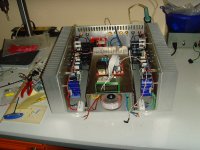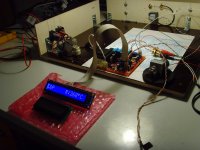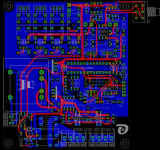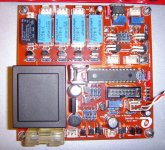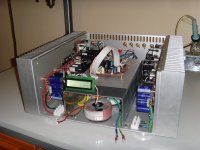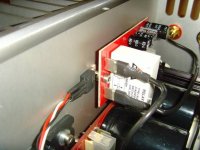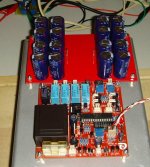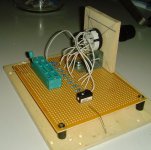After waiting more than two months for 2SA/SC transistors to arrive i've lost my patience and installed what i had on hand.
The Mje 15034/15035 are 180/220 hfe but the 2SA/SC are a bit worse 140/190 hfe if i remember well.
The Mje 15034/15035 are 180/220 hfe but the 2SA/SC are a bit worse 140/190 hfe if i remember well.
Adrian, I used the 2SA / 2SC being manufactured by ISC, when I built my prototype, and I remember that they have done a very good job as well.
Best regards - Rudi
Best regards - Rudi
A DIY-friend of mine, Andreas, and I are currently working on some improvements of our FC-100 builds.
We installed an ALU U-profile above the transformers, coated with µMetal, to absorb the magnetic field of the transformers.
We will use the top of the ALU-profile to mount supplementary PCBs and components there, for example: an additional bank of small
and fast capacitors supporting the PSUs' - backends, the LightspeedAttenuator PCB, ..., making the FC-100 an "integrated amplifier".
Apropos my Lightspeed Attenuator PCB: this small PCB does a really beautiful job! Its main job is of course to attenuate the music source's signal
(and it does this very delightfully), furthermore it selects the music source, displays the volume attenuation, the temperature of the heatsinks,
mutes, switches off-/on the FC-100, ..., and everything can be controlled by an infrared remote control unit.
I am currently working on a (the final) layout of this PCB that will include a Soft-Power-On circuit as well.
This will be the one that I will eventually offer in a separate group-buy (if there is some interest).
A SYMASYM can be built on a weekend - and that is it.
The FC-100 sounds so gorgeous that you won't stop but try to optimize its sound according to your ideas, experiences, ...
This is very challenging (be sure the FC-100 is worth it) and will take a long time, but this is why I "love" (besides its amazing sound) the FC-100.
Best regards - Rudi_Ratlos
We installed an ALU U-profile above the transformers, coated with µMetal, to absorb the magnetic field of the transformers.
We will use the top of the ALU-profile to mount supplementary PCBs and components there, for example: an additional bank of small
and fast capacitors supporting the PSUs' - backends, the LightspeedAttenuator PCB, ..., making the FC-100 an "integrated amplifier".
Apropos my Lightspeed Attenuator PCB: this small PCB does a really beautiful job! Its main job is of course to attenuate the music source's signal
(and it does this very delightfully), furthermore it selects the music source, displays the volume attenuation, the temperature of the heatsinks,
mutes, switches off-/on the FC-100, ..., and everything can be controlled by an infrared remote control unit.
I am currently working on a (the final) layout of this PCB that will include a Soft-Power-On circuit as well.
This will be the one that I will eventually offer in a separate group-buy (if there is some interest).
A SYMASYM can be built on a weekend - and that is it.
The FC-100 sounds so gorgeous that you won't stop but try to optimize its sound according to your ideas, experiences, ...
This is very challenging (be sure the FC-100 is worth it) and will take a long time, but this is why I "love" (besides its amazing sound) the FC-100.
Best regards - Rudi_Ratlos
Attachments
Last edited:
Hi Rudi,
I've Always been interested in your ligtspeed PCB.🙂
Nice work on the upgrade with the U-profile.
Regards,
Ronny
I've Always been interested in your ligtspeed PCB.🙂
Nice work on the upgrade with the U-profile.
Regards,
Ronny
Ronny, I am doing some slight progress and have annodized (varnished) the ALU-U profile
Find attached the current status of my FC-100 case and a closeup of the current version of the Lightspeed Attenuator PCB.
All of its functions work as designed and produce an adorable sound.
But you know that I am currently working on the Version 2 of the LightspeedAttenuator PCB, the final version that will include SoftPowerOn as well.
So you can do it all, leaning back in your armchair, switching on and off the FC-100, selecting the music-source, controlling the
volume, ..., with the means of your infrared-control-unit.
Best regards - Rudi_Ratlos
Find attached the current status of my FC-100 case and a closeup of the current version of the Lightspeed Attenuator PCB.
All of its functions work as designed and produce an adorable sound.
But you know that I am currently working on the Version 2 of the LightspeedAttenuator PCB, the final version that will include SoftPowerOn as well.
So you can do it all, leaning back in your armchair, switching on and off the FC-100, selecting the music-source, controlling the
volume, ..., with the means of your infrared-control-unit.
Best regards - Rudi_Ratlos
Attachments
Last edited:
This is how I fixed the LM35 temperature sensors on the heatsinks, and I have added an additional bank of fast reservoir-caps to each power-rail.
Best regards - Rudi_Ratlos
Best regards - Rudi_Ratlos
Attachments
Last edited:
Rudi, Have you experienced any vertical shift of the stereo image as the LDRs adjust the volume? Some have reported that effect with other LDR attenuation designs.
Bob: I have ordered 150 LDRs for a German group-buy and selected / matched them as close as I could!
See my selection test-rig below.
None of the German DIYers reported about any shift of the stereo image.
On the contrary: they all felt that the Lightspeed Attenuator sounds more "airy, produces deeper bass, ..."
Best regards - Rudi_Ratlos
P.S. To make the attached image more clear, I should have inserted a LDR into the SIF - socket.
See my selection test-rig below.
None of the German DIYers reported about any shift of the stereo image.
On the contrary: they all felt that the Lightspeed Attenuator sounds more "airy, produces deeper bass, ..."
Best regards - Rudi_Ratlos
P.S. To make the attached image more clear, I should have inserted a LDR into the SIF - socket.
Attachments
Last edited:
That's good to hear. From reports by U. Dailey I understand matching can be a big/long process. Looking forward to more information on your final version of the module.
Thanks.
Thanks.
For speaker protection modules i used following relays: RTE44024F.. - TE CONNECTIVITY / POTTER & BRUMFIELD - POWER RELAY, DPST-NO, 24VDC, 8A | Farnell United Kingdom
Could someone tell me if 2x8A (16A) would be enough ?
Could someone tell me if 2x8A (16A) would be enough ?
this is the only DC rating for the contacts that I can see.
I think the 6.050 is 6 thousand and 50 cycles.
But note the very low voltage for DC relative to the 250Vac rating.
As with most mechanical relays they rely on the no voltage of AC to break the arc #.
When there is no "no voltage" period as in breaking D C current then the spacing of the opening contacts severely limits the rating.
EN60947-5-1
RTE24 DC coil A/B (NO/NC) AC15, 250VAC, 3A 6.050
RTE24 DC coil A/B (NO/NC) DC13, 24VDC, 2A 6.050
RTE24 DC coil A/B (NO/NC) DC13, 250VDC, 0.2A 6.050
I think the 6.050 is 6 thousand and 50 cycles.
But note the very low voltage for DC relative to the 250Vac rating.
As with most mechanical relays they rely on the no voltage of AC to break the arc #.
When there is no "no voltage" period as in breaking D C current then the spacing of the opening contacts severely limits the rating.
Member
Joined 2009
Paid Member
I should look for a better DC specs of contacts ?
Hi, I understand that you have to be careful, I think that 99% of relays you see in commercial gear used for speaker protection are not safe for your speakers. For stopping the odd noises from power up and power off a 10A relay is fine in my view. But if you want to protect an expensive speaker from failure of the amplifier which might feed your speaker from a high dc voltage then forget most relays you can find as they will likely fail.
You can read about it on Rod Elliot's website. The issue is that the speaker is inductive and when the relay opens the contacts any sudden drop in current will result in a high emf voltage from the speaker which often produces an arc inside the relay. So the current keeps flowing. You can arrange for the relay to switch the speaker from the amplifier output to ground which will extinguish the arc but the switching time of a relay is slow. The diodes usually placed across the relay coil to prevent back emf from the relay coil damaging the control circuit actually slow down the relay.
Using two relays in parallel - could happen that they won't open at exactly the same time. One will open first, fairly easily since the other will still be closed. Then the last one will try to open.....
A far better approach, in my opinion, is to use a pair of MOSFETs with a opto-isolator to form a solid state relay. There are some threads on this topic on this forum. There are no contacts to get dirty and affect the sound and there are modern MOSFETs with negligible on-resistance so there will be less impact on sound than most relays. There's an example here
http://www.diyaudio.com/forums/soli...simple-symmetric-amplifier-7.html#post2936405
In my thread on my TGM5 amplifier I made a simple dc protection circuit. It may not the the best but it shows you another path you can take. You might be interested to note that the output stage of my TGM5 amplifier was inspired by the Roender amplifier of this thread. I like this output stage very much.
Last edited:
I would not put an relay/mosfet in series between amplifier output and speaker. You should use instead a crowbar type circuit, either mechanical or mosfet/diac based .
If one uses an output crow bar then one MUST use some form of current limiting in the supplies. Otherwise the mains will try to drive the crowbar for ever.
If one uses an output crow bar then one MUST use some form of current limiting in the supplies. Otherwise the mains will try to drive the crowbar for ever.
I would think it universal practice to fuse the mains and power rails. I've blown lots of fuses playing around on the bench and shorting this or that, but never with music, and rarely resulting in component failures.
Sheldon
- Status
- Not open for further replies.
- Home
- Amplifiers
- Solid State
- Roender's FC-100 prototype and builder's thread

